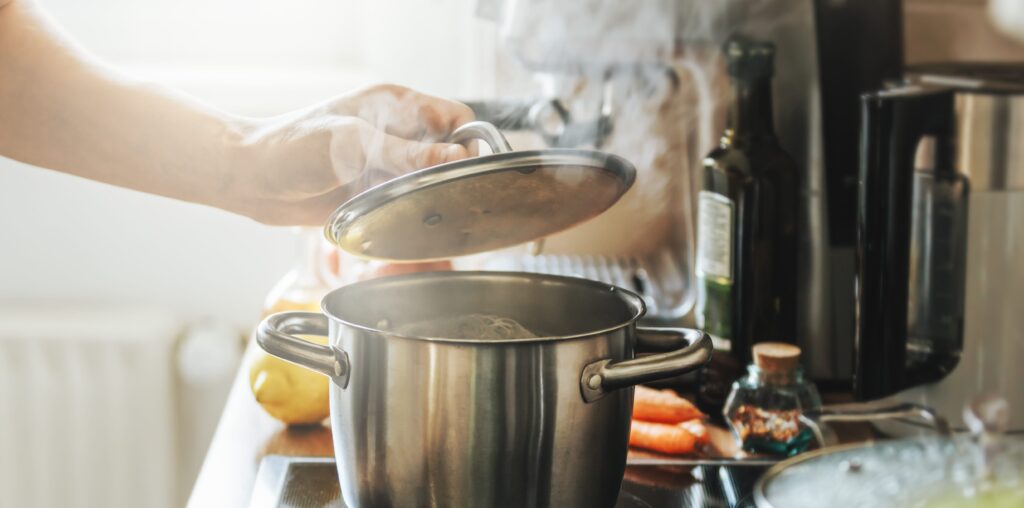A pressure cooker is a versatile and essential kitchen item that can save time and energy when preparing meals. Whether you’re an experienced chef or a home cook, having the right pressure cooker in your kitchen can make a significant difference. This guide will help you understand what to look for when picking the right pressure cooker for your kitchen, with considerations on materials, sizes, and features to ensure that your cooking experience is seamless and efficient.
Why Choose a Pressure Cooker?
Pressure cookers have been a staple in kitchens for many years. They use steam and pressure to cook food quickly, making them perfect for busy individuals who want to prepare delicious meals in less time. The high-pressure environment inside the cooker locks in moisture and flavors, ensuring that your food retains its nutrients and taste. Additionally, pressure cookers are energy efficient and can be used to prepare a wide variety of dishes, from soups to stews, beans, rice, and even meats.
Choosing the right pressure cooker, however, can be a bit daunting due to the numerous options available in the market. From the type of material used to the size and safety features, there are several factors that can impact your cooking experience. Below, we will break down everything you need to know to make an informed decision when selecting a pressure cooker for your kitchen.
Types of Pressure Cookers
Pressure cookers come in various types, and the choice largely depends on your personal preferences and cooking needs. Below are the most common types available:
- Stovetop Pressure Cookers – These are the traditional pressure cookers that you place on the stove to cook food. They are usually made of stainless steel or aluminum, offering durability and excellent heat retention. Stovetop pressure cookers are known for their ability to maintain high pressure, allowing for faster cooking times.
- Electric Pressure Cookers – Unlike stovetop pressure cookers, electric models are powered by electricity and have built-in heating elements. They often come with preset cooking programs that make cooking a variety of dishes easy, with little to no monitoring required. These cookers are great for busy individuals who want a hands-off cooking experience.
- Multi-Cookers – These are electric pressure cookers with additional functions. They can often serve as rice cookers, slow cookers, steamers, and yogurt makers. Multi-cookers are an excellent choice for anyone looking for a versatile piece of kitchen equipment that can handle a variety of cooking tasks.
Material of the Pressure Cooker
The material of the pressure cooker is one of the most important considerations. It affects the cooker’s performance, durability, and cooking efficiency. The most common materials used are:
- Stainless Steel – This is one of the most popular choices for pressure cookers. Stainless steel is known for its durability, resistance to rust, and ability to distribute heat evenly. A stainless steel pressure cooker is easy to maintain and typically offers a longer lifespan compared to other materials.
- Aluminum – Aluminum pressure cookers are lighter and often less expensive than stainless steel models. They heat up quickly, but they can sometimes warp or react with acidic foods, leading to discoloration or a change in flavor. While not as durable as stainless steel, aluminum pressure cookers can be a good option for those looking for an affordable choice.
- Non-Stick Coating – Some pressure cookers come with a non-stick coating, which makes them easy to clean and reduces the likelihood of food sticking to the bottom. If you’re using a non-stick pressure cooker, it’s important to ensure the coating is high-quality to avoid scratches or damage over time. These models are best used with non-abrasive utensils to preserve the coating.
Size and Capacity
Pressure cookers come in various sizes, and selecting the right one depends on the number of people you typically cook for and the types of dishes you like to prepare. Smaller models usually have a capacity of 3-6 liters, which is ideal for smaller households or for making quick meals. Larger models with a capacity of 8 liters or more are perfect for larger families or for preparing big batches of soups, stews, or meats.
Consider your cooking habits and kitchenware needs when choosing the size of the pressure cooker. If you already have a full cookware set, such as non-stick cookware, granite cookware, or ceramic cookware, you may not need a very large pressure cooker. On the other hand, if you entertain guests frequently, you may need a larger capacity pressure cooker to accommodate bigger portions.
Features to Look for in a Pressure Cooker
When choosing a pressure cooker, there are several features to consider to ensure ease of use and safety:
- Pressure Settings – Some pressure cookers come with adjustable pressure settings, allowing you to control the cooking speed and temperature. This feature can be particularly helpful when cooking different types of food that require specific pressure levels.
- Safety Features – Modern pressure cookers come with a variety of safety features, such as locking mechanisms, pressure indicators, and safety valves that prevent accidents. Make sure the model you choose has adequate safety features to avoid potential risks.
- Ease of Cleaning – A pressure cooker that is easy to clean will save you time in the kitchen. Look for models with removable parts, such as gaskets or silicone seals, that are dishwasher safe. Some pressure cookers also have non-stick interiors, which are easier to clean than traditional metal interiors.
- Handles – Ensure that the pressure cooker has heat-resistant handles that are comfortable to hold. The handles should also be sturdy to allow for a secure grip while cooking. Some models also have cool-touch handles for added safety.
Price Range
Pressure cookers come in a wide price range, depending on the material, size, and features. You can find budget-friendly options that are perfect for basic cooking tasks, while high-end models with advanced features can cost significantly more. While a cheaper pressure cooker may be appealing, investing in a high-quality pressure cooker can make a difference in terms of durability and performance.
It’s essential to strike a balance between cost and quality. For instance, if you’re building your kitchenware collection with items such as frying pans, cooking pots, ceramic saucepans, and soup pots, investing in a high-quality pressure cooker may be worthwhile in the long run. It can also complement your other kitchen equipment, including your pots and pans, dinner set, and drinkware.
How to Use a Pressure Cooker
Using a pressure cooker can seem intimidating at first, but it’s relatively simple once you understand how it works. Here are some general steps to follow:
- Add Ingredients – Add your ingredients and liquid to the pressure cooker. Make sure you don’t fill it beyond the recommended level to ensure there is enough room for steam to build up.
- Seal the Lid – Ensure the lid is properly sealed before turning on the heat. The locking mechanism should be engaged to prevent the lid from coming off during cooking.
- Adjust Pressure – Set the desired pressure level if your cooker has adjustable settings. If not, simply turn on the heat to high and allow the pressure cooker to come up to pressure.
- Cook the Food – Once the cooker reaches the desired pressure, lower the heat and cook the food as needed.
- Release Pressure – After cooking, you will need to release the pressure. This can be done naturally by allowing the cooker to cool down, or quickly by using the quick-release valve, depending on your recipe.
Conclusion
Selecting the right pressure cooker for your kitchen is essential to ensuring a smooth cooking experience. Consider factors like material, size, and safety features, along with how it will complement your existing kitchen items such as cookware sets, cutlery, and serving dishes. By choosing the right model, you can enjoy faster cooking times and enhanced flavors in your meals. Whether you opt for a traditional stovetop model or an electric multi-cooker, investing in the right pressure cooker will make preparing delicious meals easier and more enjoyable.
Read more blogs on thataiblog.com


